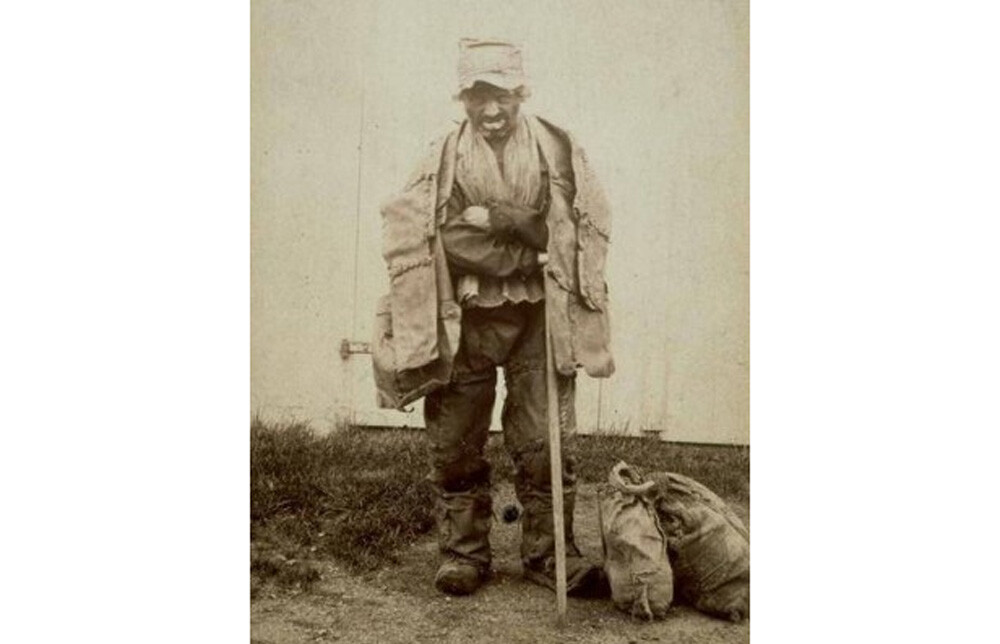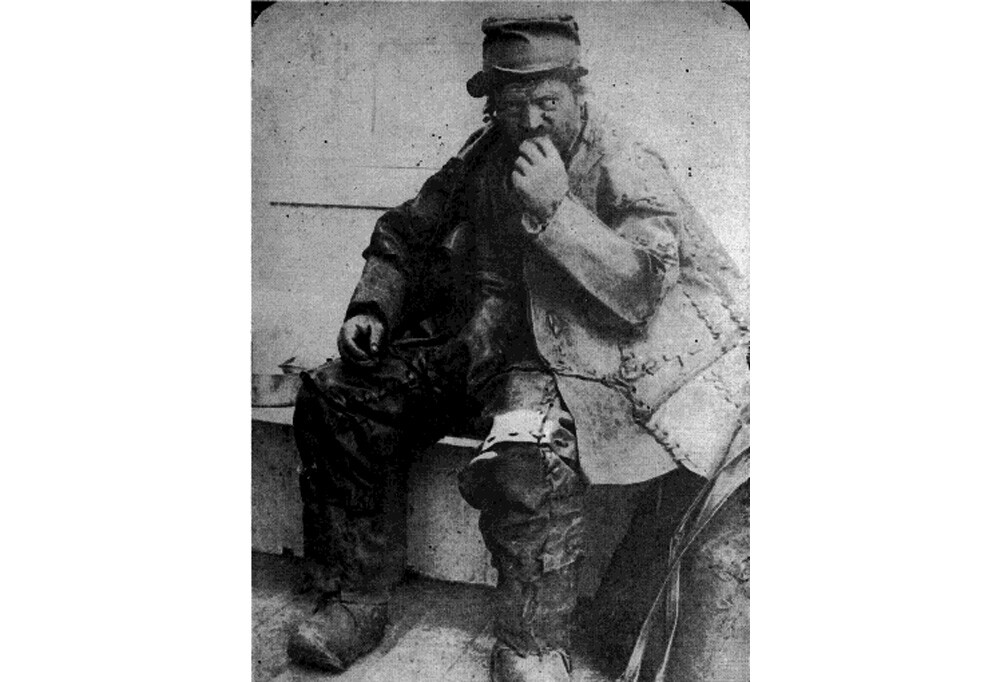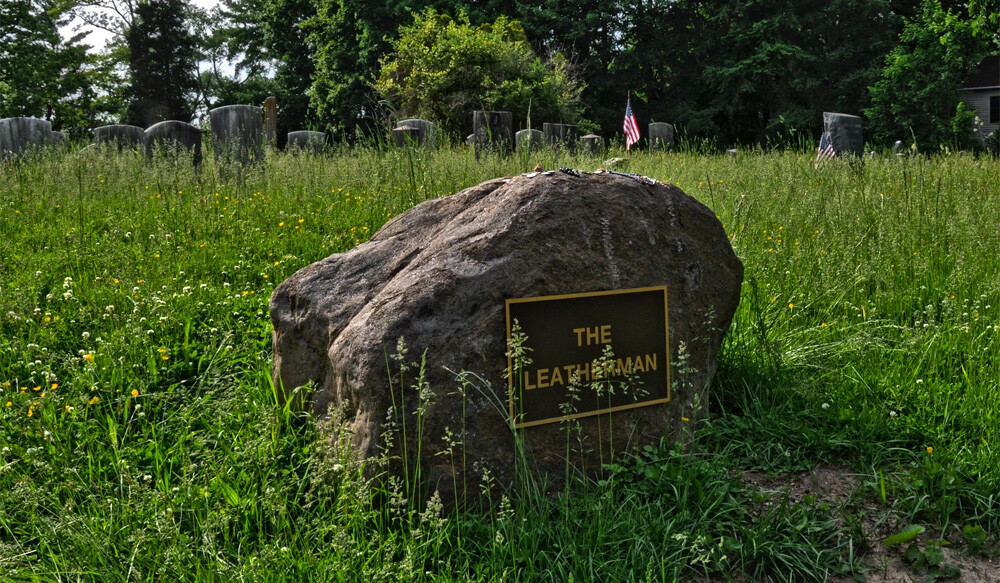For 50 Years A Silent Leather-Clad Hobo Walked The Same Mysterious Route

It's the late 19th century somewhere in New York or Connecticut. You're sitting in your one-room schoolhouse with your slate and your lunch pail and other adorable old-timey things. Then, suddenly, someone points out the window. "It's the Leatherman!" they shout, and you can see a bulky form emerging from the nearby woods, clad entirely in a rough patchwork outfit of brown leather consisting of chest-high trousers like waders held up by suspenders, a coat reaching his knees, and a hat with a visor, carrying a bag and a walking stick. He's shuffling right for the school.
Watching a man clad entirely in stitched-together leather emerge from the forest sounds like it might be pretty terrifying. Still, for people who lived between the Hudson and Connecticut Rivers between the late 1850s and late 1880s, he was a welcome sight for kids and adults. He was their pal, in his way. He was the Leatherman.

A gentle, if odd, individual, he was known to leave shiny pennies in exchange for kids' tarnished ones along school fences and seemed to tolerate their stares. Miss M. Louise Bouton, born in 1889, recalled the Leatherman "came around once a year ... always to the east side of the house. He would knock on the drainpipe. Mother would give him coffee and some sandwiches. He would say, 'Thank you so much, lady,' but never look at you. He was dressed all in brown leather. No one was afraid of him." A Greenwich, CT, resident, Russel Reynolds, 79, had a grandmother, Mary, who used to see him, and described him: "He came every few months to the kitchen door and stood there, never speaking. We would see him coming on foot a quarter of a mile down the road. Mother would fix a plate and a cup of coffee and hand it to him. He would place it on the cistern, then, after eating, knock on the door, hand the plate in, nod his head and walk on. Sometimes he would wrap part of the food in paper and put it in his pocket."
Don't Miss
Itinerant and unhoused wanderers, typically men, were not uncommon in the 19th century after the Civil War displaced many. The Leatherman, however, was a little different. For one thing, he wore an entire suit made out of boot leather that weighed about 60 pounds, and for another, he didn't exactly wander. Instead, he followed a 356-mile circuit through Westchester and Putnam Counties in New York, sleeping in caves in the woods, wearing the leather suit in all seasons. It got to the point that people would prepare extra food in anticipation of his coming. He was always happy to eat, but not so much to talk. He wandered the area for about 30 years in total, and in the last six or seven years of his life, in the 1880s, this route had become so regular that he would show up every 34 days precisely. Only the Great Blizzard of 1888, which killed 400 people, delayed him, and even then, only a few days. And he would have been carrying about 100 pounds of gear between his suit and his bag. Dude got his steps in.
Most mysteriously, the Leatherman barely spoke at all, communicating through grunts and pointing, and avoided eye contact. When he did speak, it was in French, or English with a heavy French accent, leading people to believe he was from France or Quebec. He first started being noticed in the area in 1857 or 1858, but prior to that, it was anyone's guess where he came from or why he was doing what he was doing. It's not really clear how old he was, either, as he was so weatherbeaten that he was about as leathery as his suit. But questions went nowhere, and prying too much would scare him off, which only deepened people's curiosity.
This strange but beloved figure became instant folklore, and even years after his death, his legend lives on in the areas he frequented. Today, he has a memorial in Ossining, New York, near where he died, and still influences local color, with 10K runs across his old stomping grounds named in his honor, and documentaries made about him. He even inspired a Pearl Jam song.
But still, no one knows who he was or why he chose to live his life roaming the woods and living on handouts, braving freezing winters and sweltering summers.

In 1870, the Leatherman first appeared in the news. An article in The Burlington Free Press, all the way in Vermont, called him the "Leather-Clad Man" and described how he rarely spoke and that when he did, it was in monosyllables. It also mentions a rumor that he was from Picardy, France, but that's never been verified. For the most part, he simply went about his business, and the local folks fed him. In a profile written by Samantha Hunt for McSweeney's, she says that one grocery store kept a standing order for him: one loaf of bread, one can of sardines, one pound of fancy crackers (we don't know what makes them fancy), one pie, two quarts of coffee, one gill of brandy and one bottle of beer. Religious, he declined meat on Fridays. He also smoked, accepting cigars and tobacco and picking up butts along his walk.

Although he was certainly eccentric, it was clear he was intelligent. Besides making and repairing his leather suit by hand, he also had a collection of handmade tools that helped him survive in the elements. He'd even made his own shoes. He clearly knew how to survive in the outdoors, even through the bitter winters, and had a good memory for friendly houses and shops. Curious types would follow him to his caves and see how he would set up firewood before leaving, so on his return a month later, he could simply light it. Amateur historian and author Dan DeLuca theorizes that he learned his survival skills from indigenous people or may have been partially indigenous himself.
In 1888, the Leatherman was taken in by the Connecticut Humane Society, who feared for his safety. He was arrested and hospitalized, likely a very unpleasant experience for him. While he was there, he was given a diagnosis of an "emotional affliction," but even in the 19th century, that wasn't enough reason to hold him, so they let him continue on his way. But it wouldn't be much more of a way. Due to his smoking, Leatherman developed mouth and throat cancer, and in March of 1889, his body was found in one of his many caves in Mount Pleasant, New York. It was also discovered that in addition to homemade clothing and tools, he carried a Catholic prayer book written in French, confirming that this was likely his first language. He was buried in Ossining, New York, under a reused stone with a metal plaque.

Soon after he died, an article appeared in the Waterbury Daily American that declared to know the real and true identity of the Leatherman. According to the article, the Leatherman was Jules Bourglay, a poor but aspirational young man from Lyons, who fell in love with the daughter of a wealthy leather merchant. In order to win her father's approval, he convinced him to go in on some risky leather trading, but things went awry, and they lost everything. Jules, wracked with guilt over ruining the family of his beloved, fled to the U.S. and was next spotted wandering as a penitent hermit, dressed in the material that was his downfall.
Great story, right? Well, sorry, but it's:
It was written to sell papers, the 19th-century equivalent of the most shameless clickbait, and even the newspaper retracted it a few years later. Nonetheless, the false information stuck for a long time, gathered even more embellishments, and even made it onto his former tombstone.
Besides the Jules Bourglay story, there are still a couple of theories as to what was up with the Leatherman. Maybe he was a fugitive of some kind. After all, he was extremely cagey about giving away any kind of identification and preferred to keep moving. But on the other hand, his "moving" was a very predictable route, and his appearance and behavior wouldn't exactly help him blend in and go unnoticed. Other theories suggest that he may have had a disability, possibly something like what we would now call the Autism Spectrum, citing his adherence to a schedule, dislike of talking and eye contact, as well as his intelligence. People with disabilities and mental illness were not treated kindly in the 19th century, and maybe the Leatherman had experienced this and chose to live apart from a misunderstanding society. Dan DeLuca describes the Leatherman as possibly having an "obsessive-compulsive disorder." Others have simply seen him as a man living life on his own terms. But the reality is, these are just guesses, and we'll probably never know, just like we may never know his real name or story.
In 2011, historians dug up his grave with its fictional plaque in the hopes of finding genetic evidence that might lead to identification or even a possible descendant, a decision not without controversy. But when they exhumed the grave, there was nothing there but a few rusty coffin nails. True to his evasive nature in life, the Leatherman had disappeared again. What little remained was reinterred under a new stone that simply read "The Leatherman." If you visit, you can still see tarnished pennies left on top.

Top Image: James F. Rodgers, 2112guy/Wiki Commons